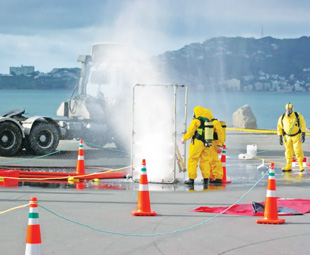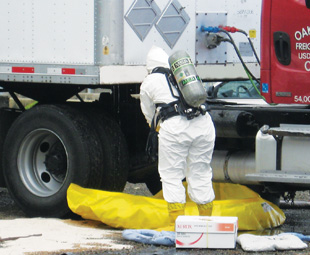Caution, spill ahead!

Mention the term “hazchem”, and many South Africans cringe. Even worse is the fact that road accidents involving so-called hazardous freight are rife in South Africa. But who is responsible for the aftermath? The costs of hazardous spillage claims have surged recently due to tightened legislation – but has this made a big enough impact in the reduction of fatalities? BLAIR BURMEISTER heads into hazardous waters to find out.
When hazardous chemicals are spilled on our roads, the consequences can be devastating – environmental damage, traffic delays, cargo damage and loss of life are among the very real possibilities. Hazchem spills also cost hundreds of thousands of rands to clean up, and can put a company’s reputation in heavy jeopardy.
Even with the recent tightening of legislation, South Africa is still seeing a great deal of hazardous freight accidents and collisions, particularly along the Johannesburg-Durban N3 highway, taking a heavy toll in terms of injuries and losses.
A recent collision involving three trucks on the N3 northbound, near Gillooly’s interchange, created a massive diesel spill. As a result, four lanes of traffic were closed. Following such an incident, the question arises – who is actually responsible for paying for damage repairs and cleaning up the mess?
“The responsibility lies with the transport company,” says Sjanine Tanner, MD of Envirosure Underwriting Managers (EUM). She explains how crucial it is for the company to be correctly insured: “The policy will cover the transporter for the clean-up costs, rehabilitation and any liability following an incident.”
Tanner explains how these spills can have devastating consequences, ranging from slightly contaminated road surfaces to large-scale contamination of the environment. “It all depends on the chemical and the volume of material spilt.”
She adds that diesel, petrol and oils are among the most commonly spilt chemicals in South Africa. “A very serious spillage can sometimes take months to clean up and the costs can sky-rocket.”
Tanner reveals that the average cost of a claim for a hazardous spillage has risen dramatically over the past four years. “The average has gone from R250 000 in 2008 to around R450 000 in 2012. This is mainly due to the tightening of legislation – the job is now being done as per proper protocol.”
Chemicals are, however, encountered throughout our lives. The chemical industry is one of the main components that drive our economy, and these chemicals have to be transported. The dangerous goods haulier carries massive responsibility on its shoulders, especially in the event of a serious collision.
It is therefore essential for these companies to have relevant insurance cover, in combination with excellent safety controls and dedication to avoiding such circumstances.
Tanner advises transport companies to consult a qualified broker to make sure they are correctly insured, with the right indemnity limits. She adds that EUM provides a specialised liability clean-up product, designed to cover the transporter’s insurance requirements.
However, Tanner warns that companies need to be aware that the policy may exclude a spill that has occurred due to perished valves or seals as a result of poor maintenance of the tanker or truck. “The insurance policy will not pay out for any spills if the transporter doesn’t have the correct professional driving permit to transport dangerous goods,” she adds. “The trucks, trailers or tankers need to be certified as roadworthy and should not be overloaded.”
Tanner explains how the majority of heavy commercial vehicle accidents in South Africa are caused by human error such as driver fatigue, travelling at excessive speed, substance abuse, bad driving habits, driver health problems and poor maintenance of vehicles or securing of loads. She adds that a small percentage of accidents are caused by vehicle or mechanical faults.
 Tanner feels that successful driver management can minimise and control the risk of hazardous spillages. “Employers need to install onboard technology systems, employ well-trained, qualified drivers, select the best routes and regularly check the health and wellbeing of their drivers. This will reduce driver fatigue.”
Tanner feels that successful driver management can minimise and control the risk of hazardous spillages. “Employers need to install onboard technology systems, employ well-trained, qualified drivers, select the best routes and regularly check the health and wellbeing of their drivers. This will reduce driver fatigue.”
While there are no statistics at present comparing South Africa to other countries, Tanner believes South Africa is still far below international standards. “Stricter laws need to be implemented before we are going to see an improvement. We have seen legislation tighten up over the last three years, but I don’t think it has been enough,” she says.
The Chemical and Allied Industries’ Association (CAIA) is doing its best to push for safer transportation of dangerous goods. The CAIA, in partnership with the Responsible Care (RC) initiative, recently held transport workshops in Johannesburg and Durban in which it provided delegates with the latest tools for improving safety performance when transporting hazardous cargo.
The RC initiative, adopted in South Africa in 1994 by the CAIA, has 174 members across the chemical sector and its allies. When companies pledge their commitment to RC, they agree to follow its guidelines of going about their day-to-day operations in a manner that minimises their impact on the environment and protects the health and safety of their employees and the public.
In her workshop address, RC manager for the CAIA, Louis Lindeque, identified hazardous freight accidents as a major concern, saying that it is essential for dangerous goods hauliers to adopt management systems to identify and control the risks involved.
“The chemical industry considers the safe transportation of its products an integral part of the RC initiative,” said Lindeque. “Continuous efforts to improve road safety are therefore part of our overall aim to improve the safety performance of both the chemical industry and its allies in the transport industry.”
She encouraged dangerous goods hauliers to take appropriate measures to prevent accidents on our highways. “The RC initiative aims to make transporters of chemicals aware of the risks when using the N3 route. In 48 percent of all crashes recorded by the N3 Toll Concession during the January to December period in 2011, heavy vehicles were involved.”
Lindeque placed significant focus on the risks driver fatigue poses when dangerous goods are being transported. She covered this topic extensively, stressing that driver fatigue has adverse effects on a driver’s physical skills, such as reaction times, co-ordination and vehicle control.
“The risk of driver fatigue has to be reduced,” she said. “This reduction relies on the co-operation between management and employees. It is the responsibility of both parties.”
It is therefore of great importance for transport companies to implement driver management and wellness programmes – “this can make such a big difference in reducing fatalities on our roads,” she said.
Lindeque highlighted another area of importance – the South African Safety and Quality Assessment System (SQAS) and Behavioural Based Safety (BBS), which she described as a set of tools.
“SQAS audits are essential for ensuring safe and responsible transportation of dangerous goods,” she says. “They are designed to evaluate the quality, safety and environmental performance of chemical distributors in a uniform manner, by means of a single, standardised assessment carried out by independent third-party auditors.”
“The BBS programme is one of continuous improvement that increases safety during road freight transport by positively influencing the behaviour of drivers through observation, coaching and communication,” she added. “The ultimate goal of BBS is to turn required behaviours into habits.”
Lindeque and the CAIA urge logistics companies that transport dangerous goods to use and comply with these tools. “The purpose of our workshops is to assist the chemical and related industries in obtaining knowledge of best practices with the aim of reducing the number of “hazchem” accidents,” she reiterated.
The initiative is, by all accounts, living up to its name of Responsible Care – doing a fantastic job in assisting and informing dangerous goods transporters about the risks involved. It’s clear that RC signatories and members are committed to reducing dangerous freight accidents.
Hazardous freight accidents are common in our country, and if legislation isn’t tight enough, there is a definite need for transporters to take it upon themselves to implement measures that will control this risk, making South African roads a safer place for everyone.
Published by
Focus on Transport
focusmagsa




